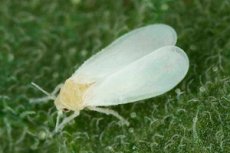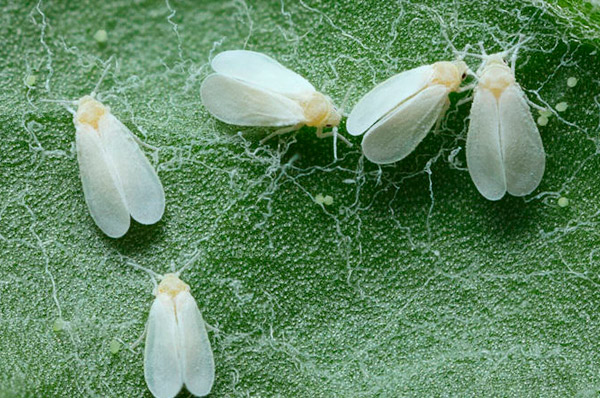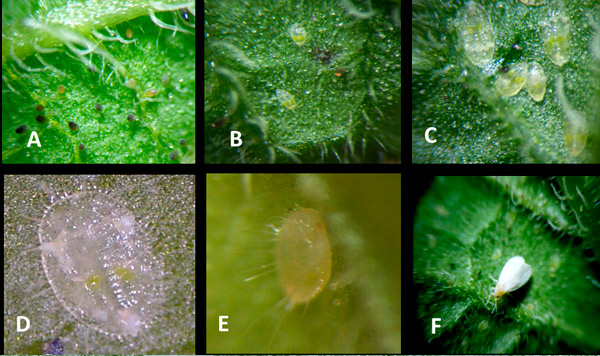Whitefly (trialeurodes vaporariorum)
Last reviewed: 29.06.2025

Whitefly ( Trialeurodes vaporariorum) is a small insect from the Aleyrodidae family, posing a serious threat to various crops, both in open fields and indoor settings. These pests feed on plant sap, leading to weakened plants and reduced yield. Additionally, whiteflies are vectors of many viral diseases, which further deteriorate the health of infected plants.
Significance of the topic for gardeners and houseplant owners:
Understanding the biology and behavior of whiteflies is crucial for gardeners and houseplant owners. Knowing how to detect and control these pests allows timely intervention and helps prevent significant crop loss and deterioration of plant appearance.
Importance of early detection and control of pests:
Timely detection of whitefly infestations and taking measures to eliminate them is key to preventing disease spread and maintaining plant health. Failure to act in time can lead to uncontrolled pest multiplication and the spread of viral infections, making plant recovery more difficult and costly.
Detailed description of the pest
Whitefly ( Trialeurodes vaporariorum) is a small insect characterized by white, powdery wings resembling pollen. Adult insects are about 1.5 to 2 mm in length and are covered with a waxy coating. The larvae and nymphs of whiteflies also have protective wax layers that help them remain unnoticed and shielded from unfavorable conditions.
Whitefly thrives in environments like greenhouses and homes with abundant plants, especially those without natural predators. These pests feed on plant sap, which weakens the plant and affects its overall health and productivity.
Taxonomy and classification
Trialeurodes vaporariorum, known as the greenhouse whitefly, belongs to the order Hemiptera and is an important agricultural pest. The scientific classification of the greenhouse whitefly is as follows:
- Kingdom: Animalia
- Phylum: Arthropoda
- Class: Insecta
- Order: Hemiptera
- Family: Aleyrodidae
- Genus: Trialeurodes
- Species: Trialeurodes vaporariorum

Global distribution
The greenhouse whitefly is widely distributed across the globe, especially in regions with a warm climate. This pest is most commonly found in greenhouses and protected environments, which allow it to reproduce rapidly and cause damage to agricultural crops. The greenhouse whitefly affects various plants, including tomatoes, cucumbers, eggplants, and ornamental plants. Due to its high reproductive capacity and ability to transmit viruses and pathogens, the greenhouse whitefly poses a significant threat to agriculture in regions with intensive farming.
Signs of whitefly presence on plants
Changes in leaves:
The first sign of infestation is yellowing of the lower leaves, curling, and deformation of the leaf tissue. Leaves may develop brown or black spots, indicating damage from the insects' feeding.
Presence of honeydew and sticky residue:
Whiteflies secrete a sugary substance known as honeydew, which can cover leaves and stems. This sticky substance attracts other pests and fosters the growth of mold (such as sooty mold), which further harms the plant.
Wilting and weakening of the plant:
Infested plants begin to wilt despite regular watering as their roots lose the ability to effectively absorb water and nutrients.
Presence of webs:
Whiteflies may create fine webs on plants to protect their nests and retain moisture.

Impact of whitefly on plants
Whitefly has several negative effects on plants:
- Physiological weakening: Feeding on plant sap disrupts normal metabolic processes, leading to a decline in overall plant health and vitality.
- Transmission of viral diseases: Whiteflies are vectors for numerous viruses, such as mosaic virus, which significantly harms plants and reduces productivity.
- Economic losses: In agriculture, whitefly infestation leads to decreased yield and quality of produce, resulting in substantial financial losses.
Causes of whitefly spread
- Plant movement:
Transporting infested plants or gardening tools spreads whiteflies to new areas. - Suboptimal care conditions:
Excessive or insufficient watering, improper lighting, and high humidity create favorable conditions for whitefly breeding. - Poor sanitation:
Dirty tools and pots can carry spores and larvae, spreading the pests between plants. - Introduction of new plants:
Introducing new plants, especially from infected regions, increases the risk of introducing whiteflies into uninfested ecosystems.
Control methods for whitefly
Mecanical Methods:
- Removal of affected plant parts:
Carefully remove infested leaves and stems to reduce the pest population. - Use of traps:
Sticky traps attract and capture adult whiteflies.
Chemical Methods:
- Application of insecticides:
Using specialized chemical products effectively kills whiteflies. It's important to follow dosing and application instructions to avoid damage to plants. - Safety tips for use:
Wear protective clothing and avoid applying insecticides to undamaged parts of the plant.
Biological Methods:
- Introducing natural enemies:
Ladybugs, lacewings, and parasitic wasps are natural predators of whiteflies and help control their population. - Use of biopesticides:
Products containing natural entomophages can help reduce pest numbers.
Natural and Organic Methods:
- Soap solutions:
Diluting liquid soap in water and spraying plants helps eliminate soft-bodied insects. - Neem oil and garlic infusions:
These natural remedies have insecticidal properties and are safe for the environment.
Combined Methods:
- Using various approaches together:
Combining mechanical, chemical, and biological methods increases the effectiveness of control and prevents resistance development in pests.
Prevention of whitefly infestation
- Regular plant inspection:
Constant monitoring of plant health helps detect infestations early and take necessary actions. - Optimal care:
Providing the right watering, lighting, and temperature conditions strengthens plants' immune systems, making them less susceptible to pests. - Application of preventive treatments:
Using insecticides or biopesticides preventatively helps prevent infestations. - Sterilizing tools and quarantine for new plants:
Regularly sterilizing garden tools and isolating new plants before introducing them into a shared environment prevents the spread of whiteflies. - Using repellents and physical barriers:
Natural repellents, such as essential oils, and physical barriers can help deter pests and protect plants. - Maintaining cleanliness and order:
Removing fallen leaves, debris, and organic waste prevents the creation of favorable conditions for pest reproduction.
Impact of whitefly on plants
- Decline in decorative quality:
Yellowing, leaf deformation, flower loss, and overall weakening of the plant reduce its aesthetic value. - Reduced yield:
In agriculture, whitefly infestation leads to decreased quantity and quality of crops, affecting farm profitability. - Weakening the plant's immune system:
Infected plants become more vulnerable to other diseases and stressful conditions, further deteriorating their health and productivity.
Specific recommendations for different plant types
- Houseplants:
- Regularly inspect plants for pests.
- Ensure optimal care conditions, avoiding overwatering and excess humidity.
- Use natural insecticides and introduce beneficial insects to control whitefly populations.
- Ornamental Plants:
- Monitor plant cleanliness and remove damaged parts.
- Use sticky traps and biopesticides to prevent infestations.
- Maintain a balanced nutrient supply in the soil to strengthen plant immunity.
- Vegetables and Fruits:
- Practice crop rotation and avoid planting the same crops in one spot.
- Use whitefly-resistant plant varieties.
- Regularly treat plants with insecticides and biopesticides to prevent pests from spreading.
- Outdoor and Greenhouse Plants:
- Control humidity and temperature levels to prevent ideal conditions for whitefly.
- Use physical barriers such as nets to protect plants from pests.
- Introduce beneficial insects for biological control of whitefly populations.
Conclusion
Whitefly is a significant pest that can cause substantial damage to both ornamental and agricultural plants. Understanding its biology, signs, and control methods allows effective population management and prevents disease spread.
Importance of regular care and monitoring:
Constant plant care and regular inspections help detect pests early and take necessary control measures.
Frequently asked questions (FAQ)
· What are greenhouse whiteflies?
Answer: Greenhouse whiteflies ( Trialeurodes vaporariorum) are small, widespread pests commonly found in greenhouse environments. They belong to the family Aleyrodidae and are characterized by their tiny, white, and fluffy wings. Whiteflies reproduce rapidly and spread efficiently, making them a serious threat to various crops grown in greenhouses.
· How to detect the presence of whiteflies in a greenhouse?
Answer: The presence of whiteflies can be identified by the following signs:
- Visual Observation: Tiny white insects on the underside of leaves.
- Sooty Mold: Fine, silvery streaks or spots on leaves caused by the secretion of plant juices.
- Honeydew: Small white spots or a thin coating on the leaves.
- Excrement: Small black dots on the leaves, which are whitefly droppings.
- Damage Symptoms: Yellowing or browning of leaf areas, leaf drop, and overall decline in plant health.
· What do whiteflies feed on, and which plants do they infest?
Answer: Whiteflies feed on plant sap using their specialized mouthparts to pierce leaf tissues and extract nutrients. They infest a wide range of crops, including:
- Vegetables: Tomatoes, cucumbers, peppers, cabbages.
- Flowers: Orchids, roses, carnations.
- Fruits: Apples, citrus fruits.
- Ornamental Plants: Marigolds, begonias, ivy. Additionally, whiteflies can transmit viral diseases, further exacerbating plant health issues.
· What are the signs of whitefly infestation on plants?
Answer: Signs of whitefly infestation include:
- Yellowing Leaves: Yellow or browned spots on the leaves.
- Honeydew: A fluffy coating on the underside of leaves due to sap secretion.
- Excrement: Small black dots on leaves, which are whitefly droppings.
- Plant Decline: Slowed growth, weakened stems, and root system deterioration.
- Fruit and Vegetable Damage: Defects on fruits and vegetables, reduced quality and quantity.
- Plant Death: Rapid wilting and death of infested plants.
· What methods are available to control greenhouse whiteflies?
Answer: Controlling whiteflies requires an integrated approach:
- Cultural Methods: Regular cleaning of the greenhouse, removal of infested plants and plant debris, reducing humidity levels.
- Biological Methods: Introducing natural predators such as parasitic wasps (Encarsia formosa) and predatory insects (e.g., lady beetles).
- Mechanical Methods: Installing screens and barriers to prevent pest entry.
- Chemical Methods: Using insecticides, though care must be taken to avoid disrupting beneficial insect populations.
- Organic Methods: Applying plant extracts, soapy solutions, and other natural agents to manage whitefly populations.
· How to prevent whiteflies from entering the greenhouse?
Answer: Preventing whiteflies involves:
- Quarantine Measures: Inspecting and treating new plants before introducing them to the greenhouse.
- Cleanliness and Hygiene: Regularly cleaning the greenhouse, removing weeds and plant residues.
- Climate Control: Maintaining optimal humidity and temperature levels to discourage whitefly proliferation.
- Use of Screens: Installing fine mesh screens to block pest entry.
- Monitoring: Conducting regular plant inspections for early detection and prompt response to infestations.
- Crop Rotation: Changing the types of crops grown to disrupt whitefly life cycles.
· Which biological control methods are most effective against whiteflies?
Answer: Effective biological control methods include using natural enemies and biocontrol agents:
- Parasitic Wasps (Encarsia formosa): These wasps lay eggs inside whiteflies, leading to their eventual death.
- Predatory Insects (e.g., Lady Beetles, Delphastus catalinae): These predators consume whitefly larvae and adults.
- Bacterial Agents (e.g., Bacillus thuringiensis): Biological insecticides that target whiteflies while being safe for beneficial insects.
- Functional Plants: Certain plants release compounds that repel whiteflies or attract their natural predators.
Utilizing these biological methods promotes environmentally friendly pest control and maintains ecological balance within the greenhouse.
· Which chemical insecticides can be used to control whiteflies?
Answer: Various chemical insecticides can be used to manage whiteflies, but it is essential to choose products that are safe for beneficial insects and follow usage instructions carefully:
- Pyrethroids (e.g., Deltamethrin, Tiametoxam): Effective against whiteflies but may harm beneficial insects if misapplied.
- Neonicotinoids (e.g., Imidacloprid, Thiamethoxam): Highly effective but there is a risk of whitefly resistance development.
- Acridines (e.g., Methyl Tertiary-Butylamino Chloride): Fast-acting but require careful handling due to potential toxicity.
- Organophosphates (e.g., Organophosphate compounds): Effective but highly toxic to humans and animals, thus their use is restricted.
- Insecticidal Soaps and Oils: Less toxic options suitable for use in environmentally sensitive greenhouse settings.
Always consult with agronomists and adhere to manufacturer guidelines when using chemical insecticides.
· What impact do whiteflies have on greenhouse crops?
Answer: Whiteflies significantly impact greenhouse crops in several ways:
- Yield Reduction: By feeding on plant sap, whiteflies weaken plants, leading to reduced growth and lower yields.
- Virus Transmission: Whiteflies can spread viral diseases, further damaging plant health and productivity.
- Fruit and Vegetable Quality: They cause defects on fruits and vegetables, decreasing their market value and quality.
- Plant Weakness: Infested plants become more susceptible to other diseases and pests due to weakened overall health.
- Economic Losses: Decreased crop quality and quantity result in financial losses for growers.
· How to properly apply insecticides to control whiteflies?
Answer: Proper application of insecticides involves several key steps:
- Choosing the Right Insecticide: Select products suitable for the specific type of whitefly and safe for your plants.
- Following Dosage Instructions: Adhere strictly to the manufacturer’s recommended concentrations and application rates.
- Application Technique: Use sprayers to ensure even distribution of the insecticide, particularly targeting the underside of leaves where whiteflies reside.
- Timing: Apply insecticides during early morning or late evening to minimize exposure to strong sunlight, which can cause plant burn.
- Repeat Treatments: Conduct follow-up applications as recommended to ensure complete eradication of whiteflies.
- Safety Measures: Wear protective gear (gloves, masks) when handling and applying chemical insecticides, and ensure proper ventilation in the greenhouse.
- Integrated Pest Management: Combine chemical treatments with biological and cultural control methods to enhance effectiveness and prevent resistance.
- Storage: Store insecticides in secure, dry, and cool places, following all storage guidelines to maintain their efficacy and safety.
- Monitoring: Continue to monitor plants after application to assess the effectiveness and make necessary adjustments to the pest management strategy.
These guidelines help ensure effective and safe use of insecticides for controlling whiteflies, maintaining plant health, and protecting the greenhouse environment.
